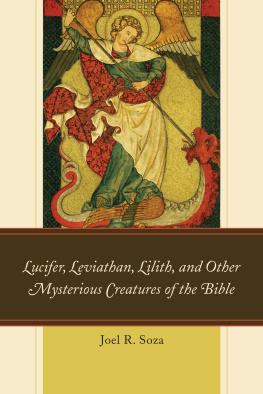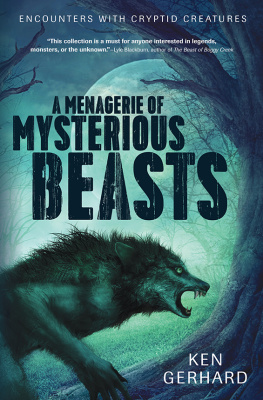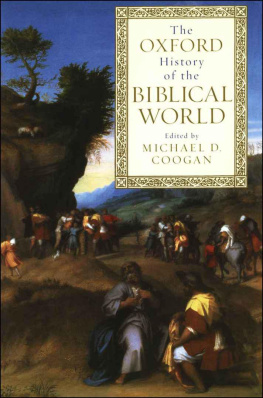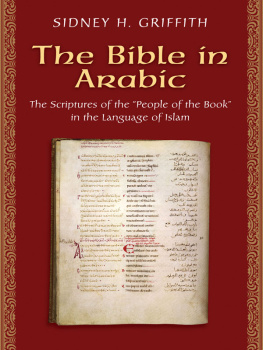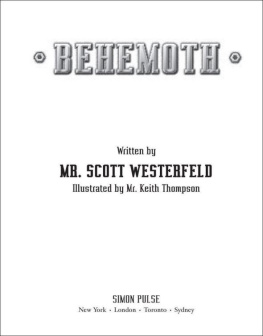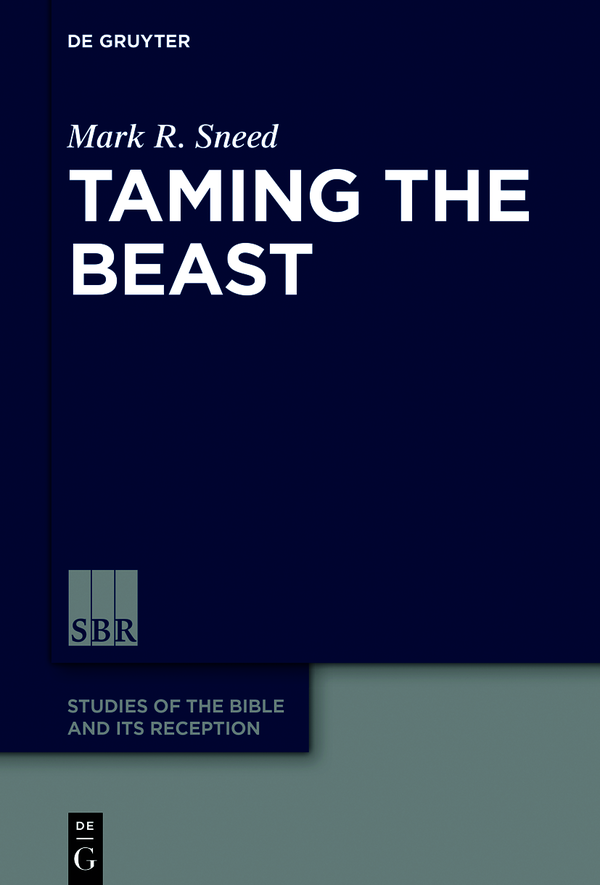Studies of the Bible and Its Reception (SBR)
Edited by
Constance M. Furey
Brian Matz
Joel Le Mons
Thomas Rmer
Jens Schrter
Barry Dov Walfish
Eric Ziolkowski
Volume
ISBN 9783110579314
e-ISBN (PDF) 9783110581591
e-ISBN (EPUB) 9783110580334
Set-ISBN 9783110581607
Bibliographic information published by the Deutsche Nationalbibliothek
The Deutsche Nationalbibliothek lists this publication in the Deutsche Nationalbibliografie; detailed bibliographic data are available on the Internet at http://dnb.dnb.de.
2022 Walter de Gruyter GmbH, Berlin/Boston
List of Illustrations
:
The Trois-Frres Sorcerer
:
Marduk upon Tiamat
:
Adad Domesticates the Sea
:
A Deity Defeats a Fiery Dragon
:
A Deity Spears a Fiery Dragon
:
A Deity Defeats a Scaly Dragon
:
A Storm God Defeats Illuyanka
:
Baal Slays a Dragon
:
Egyptian Uroboros
:
Mesopotamian Uroboros
:
Baal upon the Sea
:
Fishing for Leviathan
:
The Devil upon Behemoth
:
The Antichrist upon Leviathan
:
St. George Slays the Dragon
:
Leviathan as Hellmouth
:
The Harrowing of Hell
:
Ziz, the Giant Bird
:
Three Eschatological Beasts
:
Behemoth, the Huge Bull
:
Leviathan as Huge Fish
:
A Ketos, the Greek Leviathan
:
A Ketos Swallows Jonah
:
A Dragon and a Tree of Life
:
Seth Attacks Apophis
:
Blakes Beasts
Introduction
To indicate the modern cultural significance of both Behemoth and Leviathan, the two beasts in the second divine speech in Job, the following are my own, recent, personal encounters with them. On December 18, 2019, in Peter Traverss review (Rolling Stone) of the last Star Wars movie in the series, The Rise of Skywalker, he refers to the series, started by George Lucas, as a cultural Behemoth. On Dec 23, 2019, the gameshow Jeopardy had a category of Big Words, wherein one response question was What is Behemoth? to A grass-eating beast in the book of Job. Also on Dec 27, 2019, one of the question responses on Jeopardy was the internet Behemoth Amazon. On Dec 24, 2019, my Windows startup photo featured the California Redwood trees with the caption these Behemoths. As for Leviathan, earlier in August 2019, I was visiting Poland for a conference and near the town of Lublin I twice saw grocery stores called Lewiatan, a huge chain in Poland. More recently, in the second series of Disneys Mandalorian, first episode, premiering Oct 28, 2020, a krayt (sand) dragon is featured that eats bovine creatures called banthas. The dragon is eventually called a Leviathan, and after it is killed, its meat is eaten as a delicacy.
These creatures have also engaged the curiosity of biblical scholars. Most modern scholars view them as natural animals, Behemoth as the hippopotamus and Leviathan as the crocodile. In 2011, David Clines (1185) noted, Most scholars today have no doubt that Behemoth and Leviathan are real creatures, though the descriptions are of course literary and not necessarily realistic, perhaps not entirely accurate. In 2012, Michael Fox (261, 261, n. 2) notes, Almost all commentators identify Bememoth, correctly, as the hippopotamus. This is the consensus. Concerning Leviathan , 41823) refers to the scholarly consensus of the identification of Behemoth and Leviathan as the hippopotamus and crocodile, respectively, which goes back to 1663, the publication of the biblical animal encyclopedia, Hierozoicon, by Huegonot and antiquarian, Samuel Bochart. However, it should be noted that there is a strong minority of scholars that sees these beasts as mythological monsters.
But whatever the true natue of the beasts, scholars have debated their symbolic and theological significance. The beasts are often seen as symbolyzing Gods power and sovereignty over against Jobs impotence because he cannot restrain or catch them. Thus, Job has no right to challenge God concerning his justice in running the world. And/or they are seen as representing disorder, chaos or even evil, and, it is assumed God, as creator of these beings, has a place in his divine economy for them. The beasts then are agents of theodicy.
The consensus view of biblical scholarship has even permeated popular culture. For example, a recent Jewish coloring book depicts Behemoth as a hippopotamus and a tannin ( or sea dragon, another name for Leviathan) as a crocodile (
However, in popular culture these beasts are not usually utilized like this as descriptors for natural aninmals but as symbols for the very large, things massive and incomparable (see Thomas forthcoming). There have been several B-movies made about the beasts. The Giant Behemoth (1959) involves the resurrection of a dinosaur, perhaps a Paleosaurus, due to radioactive contamination in the sea, or Behemoth (2011), which portrays a giant underground creature that is wrapped around the world. In Leviathan (1989) one finds the creature is a huge water monster, resembling the Kraken in Clash of the Titans (2010) (see , 281). They even have influenced childrens animation films. In Monsters University, the large, blue, furry protagonist, Sulley, is called a Behemoth. And the popular tv show, American Idol, was called Foxs Behemoth (Greenspoon).
For reasons that will soon become apparent, food is often described by invoking these beasts. A few years back in the United States, there was concern about a large lobster that might have been eaten: Bubba the Leviathan Lobster to Live On in the Pittsburgh Zoo & Aquarium. The gastronomical metaphors continue with Behemoth hamburger [weighing in at 1 pound] puts up a fight at Californias Hazel Restaurant (). Starbucks has been referred to as the US coffee Behemoth (Greenspoon). Similarly, the bookstore, Borders, was once described as Bordering on the Behemoth (Greenspoon), though, unfortunately, it has recently gone out of business. Of course, Walmart has been described as Behemoth (Greenspoon).
So, why is there this difference between popular culture and biblical scholarship? And which view is correct? Surely biblical scholarship should be given the benefit of a doubt, and we should rely on their expertise, right? Or is it possible that biblical scholars are biased themselves and do not come to the texts about these beasts from an objective standpoint?
Another interesting factor is that as pervasive as the beasts place is in popular culture today, they form relatively little part in current Christian theology. Exceptions are fundamentalist creation scientists, who see the beasts in the second divine speech as dinosaurs and the best biblical evidence for human cohabitation with dinosaurs. Also, many Jews value the beasts, along with a third one, a giant griffin or bird-like creature called Ziz, as the source of food for the redeemed in the eschaton. There are coloring books that depict these creatures, such as The Ziz and the Hanukkah Miracle (Jules 2006), in which the huge bird helps the Maccabees find oil for the Temple menorah.
For Protestant Christians today, the beasts only emerge as a topic of discussion usually during a Sunday School class on the book of Job. Otherwise, they form no actual part of the tradition and have little if any relevance. Among Catholics, they are not insignificant, however. Leviathan is portrayed as a motif in iconography in older cathedrals. Just a few centuries ago, medieval Christians would constantly see iconography that depicted Leviathan as the jaws of hell or Hellmouth, revealing its terrifying jaws with large teeth swallowing the damned. Connected with this, the motif of Harrowing of Hell or Descent into Limbo usually involved the depiction of Leviathan, an event celebrated on Holy Saturday during Easter week. The Harrowing of Hell depicts the time between Christs death and his resurrection, when he visited the poor spirits in prison in Hades, a la 1 Pet 4:6. This event is in fact part of the Apostles Creed, and, thus, one could argue should be no insignificant doctrine for the church, Catholic or Protestant. However, the beasts as a couple form no great theological significance for Catholics today. At least one can say that their significance has declined.


